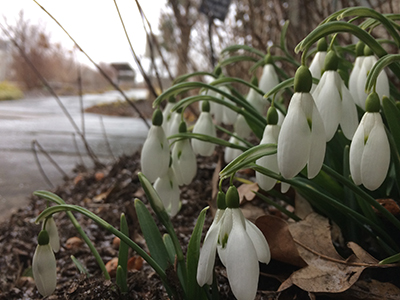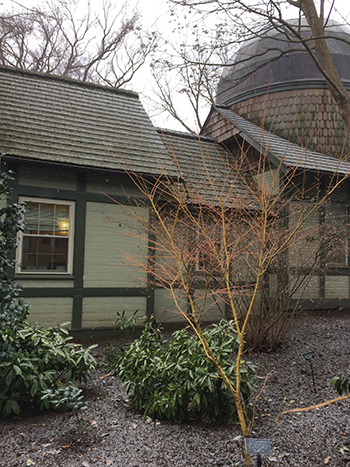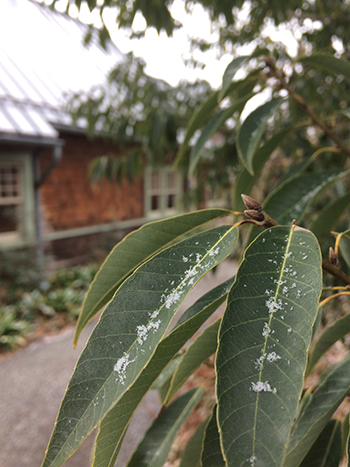
Galanthus ‘Magnet’
Though this is an old cultivated variety of snowdrop, it still never fails to awe and impress as it returns year after year, emerging from the desolate winter landscape. Best known for its long flower stalks and large, showy, snow-white flowers, ‘Magnet’ was discovered and introduced into cultivation sometime in the 1880s. Sources indicate that the genus name is a combination of gala- meaning “milk” and -anthos meaning “flower” referring to the pendulous, bright white tepals.
Preferring full sun to part shade and appreciating a dry, shady dormancy, Galanthus pairs well with other early spring ephemerals, especially Eranthis hyemalis, which blooms around the same time in mid-February. This specimen can be found beneath the Camellia outside the door to the Off Campus Study Office attached to the Cunningham House. Photo credit: J. Bickel

Acer palmatum ‘Bihou’
An unexpected pop of winter yellow-orange that goes by the name of Acer palmatum ‘Bihou’ resides in a nook in the upper section of the Scott Entrance Garden near the Cunningham House. This Japanese maple cultivar is small, but packs a colorful punch in the winter months with striking yellow bark. Each twig culminates in a small pair of fire-orange bud scales protecting the dormant leaves.
The bark color of ‘Bihou’ and an orange-yellow flowered witchhazel would make a striking plant combination. The witchazel would bloom when the bark of A.‘Bihou’ is most vibrant. In the Spring when the leaves of this Japanese maple emerge, they are bright chartreuse and by fall the leaves are yellow-orange making yet another strong statement. Photo credit: J. Bickel

Quercus myrsinifolia
The Chinese evergreen oak Quercus myrsinifolia is truly an oddity in the oak genus. Other than the acorns they produce, there are few clues that would point the layman to the conclusion that this tree is a Quercus. The evergreen leaves are narrow and lance-shaped with finely-serrated edges while the bark is smooth and grey. This oak is native to Eastern Asia and found in full sun conditions.

Quercus myrsinifolia is a medium-sized tree that can reach heights of 30 feet. The species name purportedly comes from the leaves’ superficial resemblance to those of some species in the myrtle family Myrsinaceae. One large specimen can be found between the Wister Center and Cunningham House. Another smaller specimen can be found on the bank behind Willets residence hall near the cut flower garden behind the hoop house.
This specimen tree is a great garden plant with evergreen leaves and a clean appearance. Photo credit: J. Bickel
